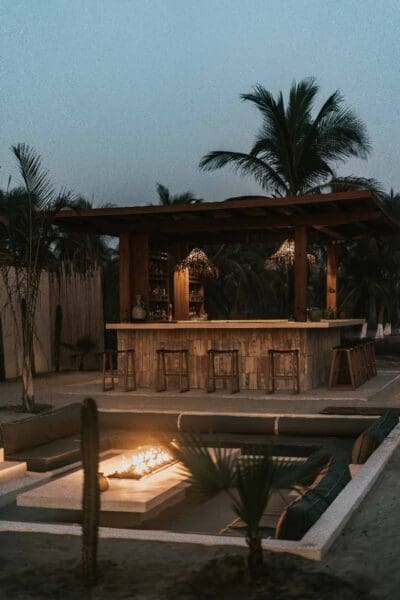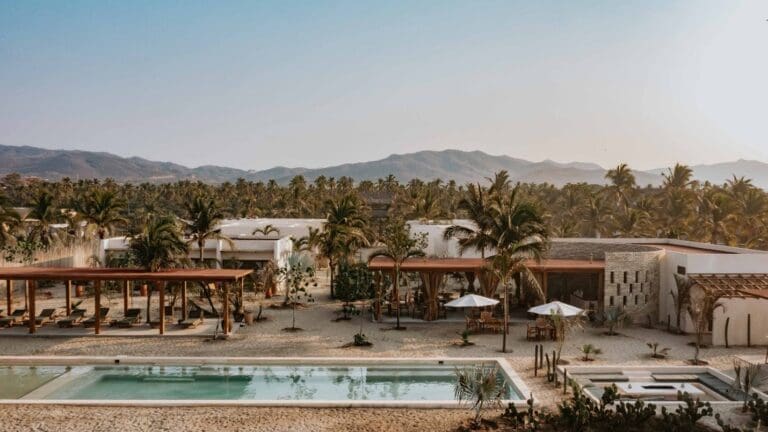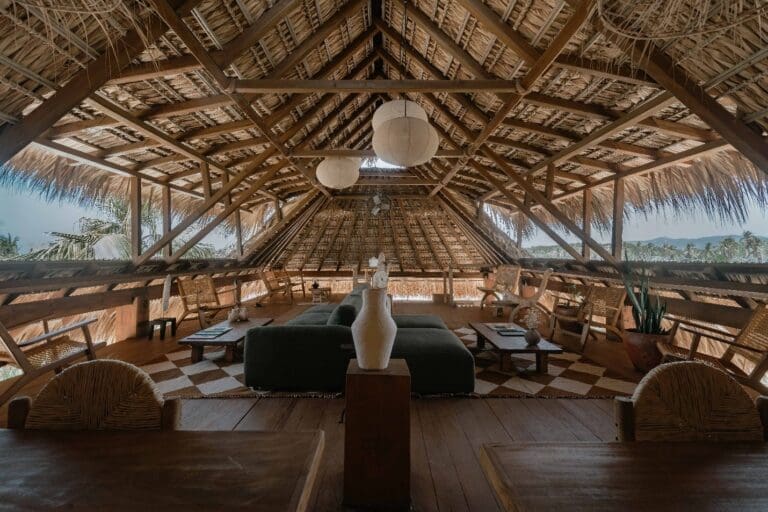A market intelligence report that aggregates data is unable to identify one of the most important trends in hospitality. The internet and social media are used by travelers all over the world to find authentic hotels with a unique vibe and a strong connection to their surroundings.
Behind the scenes – and what’s hard to quantify – is just how often the hotels curating these authentic experiences are led by independently spirited owners and operators who have a passion for hospitality and a clear vision for creating a unique property.
In this case, we’re speaking with Tim de Belloy – one of three owners of Casa Yuma alongside Camille Lambert and Sara Skalli – a 25-key boutique resort that opened in March 2024 along the Oaxacan coast in Southern Mexico. Casa Yuma, a 25-key boutique resort nestled on the white sands of Los Naranjos is located just a few kilometres outside of Puerto Escondido.
The Pacific Coast City is quieter compared to Los Cabos, or Puerta Vallarta. But it’s still a destination that has long been known for its surfing on Zicatela Beach, and yoga retreats located in La Punta. Puerto Escondido is booming, with new developments, design hotels, and resorts dotting the coastline.
For Casa Yuma, we’re focusing on the growth of the ‘barefoot luxury’ or ‘laidback luxury’ trend where modern guests’ idea of luxury is no longer just opulent décor and elaborate service but meaningful experience, in this case on a beach in Oaxaca. The hotel’s story of founding is timeless: a group of friends fell in love with the destination and decided to open a new hotel to help others experience the same.
 What makes Puerto Escondido so special?
What makes Puerto Escondido so special?
Puerto Escondido was a hot spot in the surfing and yoga communities for quite some time. But what has happened over the last ten years is much more. The first time I visited the Oaxacan coastline, I immediately felt an energy I had never experienced anywhere else in Mexico. It was a raw and grounded energy that brought me closer to nature.
Puerto Escondido is not like other beach resorts. It feels undeveloped and wild. It’s relaxed but rich in culture. Puerto Escondido has a port, a town and businesses. As a guest or tourist, you can blend in with the locals. Oaxaca has a rich history and culture that will never be lost to tourism.
Los Naranjos’s remarkable untouched nature is what attracted us to it. The mountains and Pacific Ocean flank you on either side. At night, the only sounds are the sound of the ocean and the wind blowing through the palm trees. This is a place in Puerto where the time seems to slow down. There’s no commercial strip, no big resorts – just the land, the ocean and a small, tight-knit community that respects both.
Casa Yuma was to be a reflection of that spirit, a place where people can feel calm and at peace. It should also respect its environment. We did not want to build something that disrupted the landscape, but rather that seemed born out of it. It’s this special stretch of coastline that makes it so beautiful. Our architect’s goal was to make sure that if you were passing by on a beach or a boat you couldn’t tell there was a hotel.
We love hearing about hotels’ origin stories. How did Camille, Sara and you come together to create Casa Yuma?
Casa Yuma was a dream that two friends shared. Sara, Camille and I were all drawn to Puerto Escondido for different reasons – its natural beauty, the rhythm of life here, the surf and the colors of the coast that change throughout the day and the season. It’s a magical place, but what brought us all together was our shared desire to create something meaningful. We talked for hours on how to make hospitality feel more personal and more connected with the place. The conversations ceased to be hypothetical at some point.
Spending enough time in an area allows you to feel its potential. Before Puerto became a mainstream destination, we saw it changing: travelers and creatives looking for authenticity and not just the amenities. People who wanted to disconnect, surf, reconnect and slow down, but still be active. We thought this was the perfect time to protect and preserve that spirit, while also offering something beautiful.
Trust and mutual respect allowed the transition from friends into cofounders to happen naturally. Each of us brought a different strength to the table – Sara with her design eye, Camille with operations, myself with the brand vision – and it felt like the most organic thing in the world to build Casa Yuma together.
It is a global trend that transcends both geography and demographics. What types of guests are you expecting at Casa Yuma?
What we’re seeing at Casa Yuma is this new kind of traveler – one who values substance over flash. Our guests are often curious, well-traveled and conscious. Our guests are curious about the origins of materials, who makes them and if the hotel is in harmony to its environment. The surf, sunsets and mezcal are all important, but so is the feeling of space, reconnecting with nature, the sound of waves breaking at the beach, and the ability to relax.
This idea of ‘barefoot luxury’ speaks to something bigger happening in hospitality. We invite people walk and remove their shoes, as though they were in their own summer house or beach house. The new generation of travelers today is looking for personalization, adventure and spaces which feel like they are living in. We saw an opportunity in a tech-driven and fast-paced society where we are less face-toface. That’s why we designed Casa Yuma with gathering in mind – creating warm, open common areas that naturally encourage conversation and connection among guests.
The goal is to reduce the pace of life without sacrificing quality. When a space has been created by people who love it, this energy can be felt in each detail. Sara and myself personally installed each piece, room by space. This is the magic of owner operated properties. We’re more than just a hotel. We’re opening doors to the world we’ve invested our hearts in. As travelers continue to seek out places with character, meaning and connections, this segment of hospitality is only going to grow.
It’s the dream of every hotelier to open a boutique. But it is a long, arduous process that can take years. What were the challenges you faced and how did overcome them?
Casa Yuma is a labor of love for us. We wanted to do it correctly, so we spent the time necessary to fully understand the region. From navigating Mexico’s property laws to building sustainably at a remote location on the beachfront, this meant understanding every nuance. This required patience when it came time to build and obtain permits, as they move in a different pace here. It is important to have patience and confidence!
Choosing to build in such a manner that we honored the land presented its own set challenges. Working with Chukum, and other materials from the area meant finding skilled artisans to work on our designs and adapting them to the terrain and climate. But these challenges became a part of Casa Yuma’s story. They are the reason it feels like it does.
We built solid relationships at the local level. It made a big difference. Since the first day, we have worked with people who are local, who care deeply about this area and its future. We were able to overcome all obstacles with the mutual respect we had. The challenges were worth it in the end.
In terms of distribution and RevPAR forecasts, having a hotel flag is a must. Was opening an independent property always in the plans?
Casa Yuma’s launch as a standalone hotel was a deliberate decision. From the beginning, we wanted complete creative freedom – to design an experience that felt personal, rooted in place and free from the rigidity that can come with being part of a larger flag. We didn’t follow a set template. We wanted to build something that felt organic, like an extension to Puerto Escondido.
Of course, going independent means more responsibility on the marketing and operations side, but the payoff is that everything – from our design choices to the way we welcome guests – is infused with our values.
 Puerto Escondido has been passingly described as ‘the next Tulum’ but I find this comparison to be belittling to Puerto! What are the unique design styles and cultural offerings of this region?
Puerto Escondido has been passingly described as ‘the next Tulum’ but I find this comparison to be belittling to Puerto! What are the unique design styles and cultural offerings of this region?
Puerto Escondido is a unique place. It’s tempting, I agree, to compare it to places like Tulum. But doing so misses its soul. Puerto Escondido is not trying to be something other than itself. A big key factor is that key people that run Puerto Escondido are keeping the big clubs and parties away, so Puerto will never attract the same tourists and will never be ‘Tulum’.
The design ethos here is rooted in materials that are native to the land – like Chukum, a beautiful eco-conscious ‘vegetal concrete’ made from tree resin and limestone – and the use of Oaxacan brick, handcrafted wood and other elements that feel honest and enduring.
Puerto has a raw, elegant quality that is not the result of imported ideas but rather a respect for local culture and nature. It’s in the food, architecture and pace of life. It’s more about authenticity than trends. Casa Yuma tries to maintain that spirit. Nothing is too polished, but it is all thoughtful.
How does Casa Yuma manage the area in relation to this?
Stewardship is the foundation of everything we do. Our approach from the beginning was to build on top of the land and not with it. We used Chukum and other sustainable materials to minimize our environmental impact, and we work almost exclusively with local artisans – from the handwoven rugs in our rooms to the ceramic lamps and tiles you’ll find throughout the property.
Our restaurant sources everything locally and according to the season. Our chefs work with local producers and fishermen to elevate Oaxacan products in a respectful way. Think handmade tamales and mole made with fresh seafood.
Our team is comprised of local talent, and we are very proud of that. Everyone – from our front-of-house staff to our kitchen team – is from the region. It’s important to us. Casa Yuma should be a place which not only celebrates Puerto Escondido’s rich culture but also contributes actively to the economy and future of Puerto Escondido.




